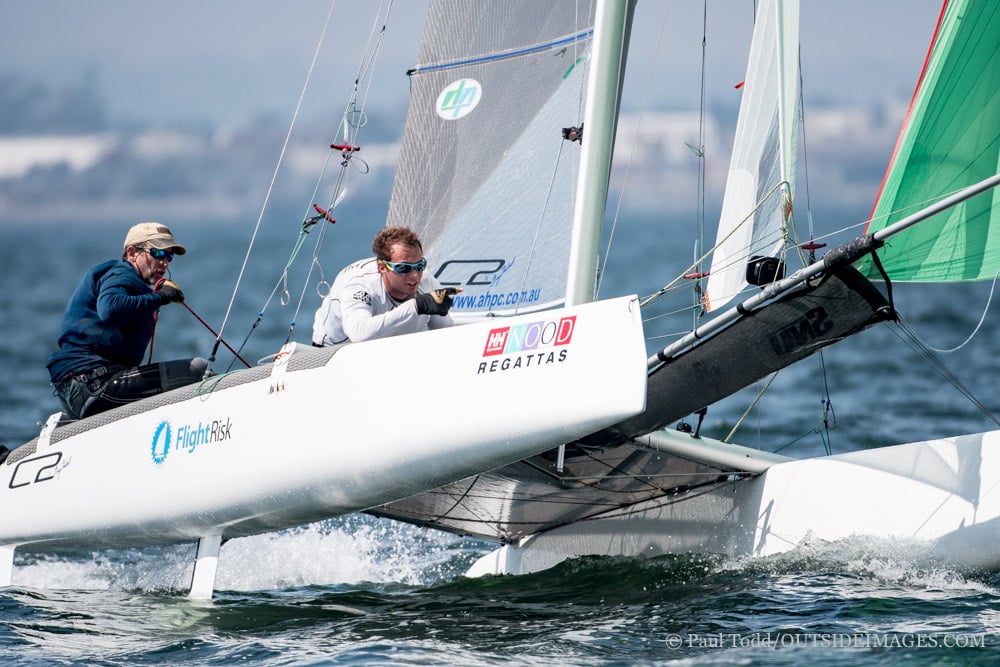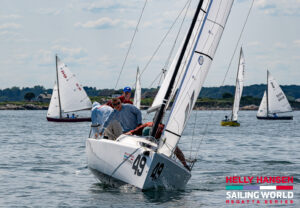Steve Stroebel has a weapon of a new boat, and this morning on the beach at Coronado Island’s Fiddler’s Cove he’s meticulously prepping it for the day’s races, three informal skirmishes for the Formula 18 catamaran teams that are in San Diego for this weekend’s Helly Hansen NOOD Regatta. He’s only sailed the boat once, and it shows.
There’s not dimple in the hull to be found, the sails are stiff and crisp, the lines still slick with their waxy new-rope coatings. Inside the black rudder blade bags are blades so sharp and polished they reflect the early morning sun rising over San Diego Bay.
It’s pretty obvious Stroebel is itching to get out on his new toy. He’s rigged himself, he’s ready to go hours before he has to shove off the beach. He’s just waiting on his crew, happy to talk F18s.
“Boatspeed is a big part of the game,” he says. “We’ve had a lot of converts from monohulls and their reaction is always that they don’t realize how tactical the boats can be. It’s just that we are going higher speeds. When you’re coming into those leeward mark roundings, for example, the rules are important so we don’t play it quite so close with other boats because it can be pretty bad if you hit.”
And given the boats are “box rule” and therefore not exactly alike – although to the naked eye a casual observer might see otherwise — speed differentials create space on the course and allow each team to sail their boat to its full, high-speed potential. “Tactics are important, especially with deciding which side of the course you want. We have to be careful about when we tack. With these boats we won’t tack five times up a windward leg. We can, however, you do more jibing downwind because the jibes are not so detrimental.”

He remembers his first F18 experience vividly. Five years ago, when he bought a Hobie Wildcat and raced it in Long Beach with the simple goal of getting around the course, staying upright and not hitting anyone. Today, he’s well beyond that.
“The boat moves so incredibly fast, but the platform is stable, he says, comparing his past experiences to sailing Snipes. “When it comes to jibing downwind in 25 knots, I’d much rather be on this boat.”
Still, the boat is physical, so don’t let anyone kid you. Maybe helmsman has it a bit easier. It’s the crew that does all the work. “The helm just steers, and when we’re both on the trapeze, with the spinnaker up, tight reaching, it’s is such a blast. Our typical speed with spinnaker is 18 knots upwind and 13 knots downwind, depending on the wind. It takes a lot out of the crew.”
His personal max speed? He’s happy to claim 22 knots, on flat water close reach. “It’s incredible,” he says with big grin. “The water is just flying off the boat.”
Most of his life he was a monohull sailor, both dinghies and keelboats, and as committed multihull convert, he can look back with experience with some sage advice. “It’s just a matter of trying. They’re very addictive and just a thrill to sail them. Once you learn to sail them, they’re straight forward.
Of course, there’s talk about foiling, but he and others in the class are dead set against it. “It would be a big mistake. For people who want a thrill but not foiling, F-18 is the class for them. The boat keeps me young and that’s why I sail it. You do need to be relatively fit. I swim a lot when I’m not on the water, but the best thing to do is get out on the boat and just sail it.”









